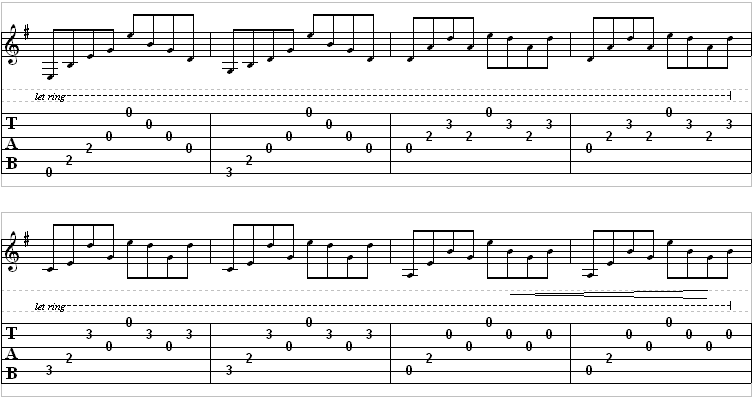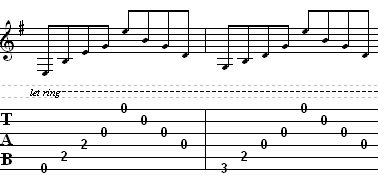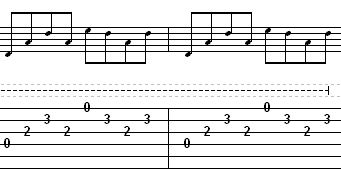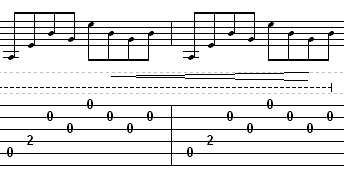Riff RundownDifficulty: Easy - Intermediate Composer - Originally "The Who" ( Pete Townsend ) Where to find this song - Results May Vary track #15 Release Date - September 2003 Limp Bizkit is known for more of their harder, rap-oriented alternative music. After losing Wes Borland, the band, mainly Fred Durst, (frontman) started working on music with a little different style. They churned out a classic "Who" hit and have once again bounced onto the charts and are holding their own with other top-notch contenders. Here is the song as performed by "Limp Bizkit." Intro/Verse Riff
How To Play ItPart 1 The first part is going to be an Em, G, D, and C-based chord progression and picked to let all notes ring throughout the song. Remember that when we are using an Em in this song we will need to place our 1st finger on the "A" string on fret 2 and our middle finger on the "D" string on fret 2. To actually pick this first part, you will need to start and pick at your index finger, then to your middle finger. After you have done that, you will need to pick in this order: Start picking from the "G" string, then to the "high E" string, ( the string furthest from you when looking down) then back a string to the "B" string, then back down one more string to the "G" string. After you have done that, simply play the "D" string and remember to let all notes ring. Also, remember you are playing all of these open as you can see by the tablature, so experiment with the notes a bit and you will get the pattern down for this measure. The next measure will be a loosely-based G chord. To perform this part, remember how you had your fingers in the first measure. Keep your index finger where it is. All you need to do is pull your middle finger from the "D" string and put it on the "low E" string on fret 3. That is a G chord. Start picking in the same fashion as you picked in the first measure. These two measures will be the same, so try them over and over and you will get used to playing this progression. Remember again to let these notes ring.
Part 2 The third measure is a loosely-based Dm chord. This part may be a little bit more difficult, but just remember that all you are doing is still basically picking out a very basic chord. Here is how to play this measure: To start off, place your index finger on fret 2 on the "G" string, and then place your middle finger on the third fret on the "B" string. That is your chord for this measure. All you need to do now is follow this order: Play the open note that you see on the tablature on the "D" string, then play the "G" string with your fingers still in place from where they were when we started. Then play the "B" string on the third fret. After that, you play the "G" string again, without moving any fingers, and then play the open "high E" string. Last for this measure, play the "B" string, then the "G" string, and lastly the "B" string again. That is is for this measure, and GUESS WHAT?? The next measure is played exactly the same.
Part 3 This first measure in part 2 is based around a C chord, with a little modification. Ok, what you will want to do is place your fingers in the shape of the C chord. That is achieved by putting your ring finger on the "A" string on the third fret. Then place your middle finger on the "D" string on the second fret. Now, here is where you may be a bit confused. Usually, with a C chord, your index finger is placed on the first fret on the "B" string, but instead, just use your pinky finger and place it on the third fret on the "B" string. After you have done that, start picking as follows: Pick from the "A" string, to the "D" string, to the "B" string, to the "G" string, to the "high E, " to the "B" again, to the "G," and lastly to the "B" string. Now, if you kept your fingers in place you will have just played the first measure. Measure 2 is played the exact same way. Notice how the song is arranged. The last two measures are the same in the first part, and the first two measures and the last two measures are the same in the second part.
Part 4 For the last two measures, you will need to base them both around that Em chord again. These are probably the easiest measures to play. To play them, place any finger on the "D" string, and the rest of the notes are open. Pick like this: Play the "A" string, play the "D" string ( with your finger in place), play the "B" string, play the "G" string, play the "high E" string, play the "B" string, play the "G" string, and finally play the "B" string. That is it. If you follow this pattern and place your fingers accordingly you will do just fine in this song.
Riff ResourcesComplete Transcription To "Behind Blue Eyes" (PDF) Complete Transcription To "Behind Blue Eyes" (Power Tab)
|





